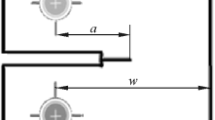Abstract
An approximate analysis is presented for the calculation of the plastic energy dissipation rate during stable growth of a centrally located through crack. in a sheet subjected to gradually increasing uniaxial tension normal to the crack plane.
It is shown that the plastic energy dissipation rate is a function of the slow growth parameter (δωp/δσ)·(dσ/da)+(δωp/δa), where ωp is the plastic enclave width in the plane of the crack and dσ/da is the rate of increase of the gross stress with respect to stable growth. At the point of instability this parameter becomes equal to δωp/δa. By assuming that this parameter is zero at the point of instability, a simple expression is obtained for the plastic energy dissipation rate.
The analysis excludes the energy dissipation rate resulting from energy changes in an inner “fracture zone” in the immediate neighborhood of the crack tip in which it is presumed that fracture processes such as vacancy formation, crack initiation by dislocation pile ups etc., are active. The analysis is not applicable in this inner zone as deformation is not homogeneous.
Résumé
On présente une analyse approchée pour le calcul de la vitesse de dissipation de l'érgie de déformation plastique au cours de l'extension stable d'une fissure située au centre d'une tôle et traversant celle-ci de part en part, lorsque cette tôle est sujette à une contrainte uniaxiale, normale au plan de la fissure, et graduellement croissante.
On montre que cette vitesse de dissipation est fonction du paramètre d'extension lente: \(\frac{{\partial w_p }}{{\partial \sigma }} . \frac{{{\text{d}}\sigma }}{{{\text{d}}a}} + \frac{{\partial w_p }}{{\partial a}}\) où ωp est la largeur de l'enclave de déformation plastique dans le plan de la fissure, et dσ/da le taux d'accroissement de la tension nominale par rapport à l'extension de la fissure dans des conditions stables.
Au point d'instabilité, ce paramètre devient égal à δωp/δa, en supposant que sa valeur soit nulle, on aboutit à une expression simple de la vitesse de dissipation de 1'énergie de déformation plastique.
L'analyse ne considère pas la vitesse de dissipation qui résulte de modifications de l'énergie au sein d'une “zone de rupture” interne, et située dans le voisinage immédiat de la pointe de la fissure. Dans cette zone, l'on présume que les processus de fissuration tels que la formation de lacunes, ou l'amorçage d'une fissure par empilements de dislocations, etc., sont particulièrement actifs. L'analyse n'est pas applicable dans cette zone interne, car les déformations n'y sont pas homogènes.
Zusammenfassung
Es wurde eine mehr oder weniger genaue Analyse für die Kalkulation eines plastischen Energiezerstreuungsverhältnisses während stabilem Wachstums eines zentral lokalisierten Durchrißes in einer einfachen Anspannungsplatte präsentiert.
Man zeigte, daß das plastische Energiezerstreuungsverhältnis eine Funktion des langsam wachsenden Parameters \(\frac{{\partial w_p }}{{\partial \sigma }} . \frac{{{\text{d}}\sigma }}{{{\text{d}}a}} + \frac{{\partial w_p }}{{\partial a}}\) ist, wobei ωp die eingeschlossene, plastische Weite in der Rißebene und dσ/da das Wachstumsverhältnis des Rohdruckes mit Rücksicht auf das stabile Wachstum, darstellt.
Diese Analyse schließt das Energiezerstreuungsverhältnis vom Energiewechsel in einer inneren “Bruchzone” in der unmittelbaren Nähe der Rißspitze aus. Man nahm nicht an, daß these Veränderung homogen, sondern auf Vakanzen, Verschiebungen, etc. begründet sei.
Similar content being viewed by others
Abbreviations
- 2a :
-
Crack length
- t :
-
Thickness of sheet
- W :
-
Width of sheet
- σ:
-
Gross stress applied at infinity normal to the crack plane
- A, τ0, n :
-
Parameters in a Ramburg-Osgood representation of the octahedral shear stresss-hear strain curve
- τoct :
-
Octahedral shear stress at any point near the crack tip
- γoct :
-
Octahedral shear strain at any point near the crack tip.
- τ supelinfoct :
-
Octahedral shear stress at any point near the crack tip given by elastic analysis
- τoli :
-
Octahedral shear stress at yield
- β:
-
τoli/τ0
- α:
-
τ supelinfoct /τoli
- \5m:
-
τoct/τoli
- E :
-
Young's modulus
- E s :
-
Secant modulus
- G :
-
Shear modulus
- G s :
-
Secant modulus of the octahedral stress-strain curve
- u p :
-
Plastic energy density at any point inside the plastic enclave at the crack tip
- U p :
-
Plastic energy dissipated in the plastic enclave per unit thickness
- v :
-
Poisson's ratio
- r, θ:
-
Polar co-ordinates with the crack tip as origin
- K :
-
Stress intensity factor
- ωp :
-
Plastic enclave width given by Irwin's formula
- f 1, f 2, f 3 :
-
Functions of θ, defining the stress field near the crack tip
- f e :
-
f sup2inf1 −f 1 f 2+f sup2inf2 +3f sup2inf3
- τoct :
-
Limiting octahedral shear stress beyond which homogeneous plastic deformation is not possible since fracture processes such as vacancy formation etc., become active.
- \5m0 :
-
τ supuinfoct /τoli
- C :
-
(δωp/δσ)·(dσ/da)+(δωp/da); slow growth parameter
- B :
-
(G·A/τo1i)·βn
References
A. Griffith, Phil. Trans. Roy. Soc. (London), 221A (1921) 163–198.
G. R. Irwin, Fracturing of Metals, ASM, Cleveland, (1948) 147–166.
E. Orowan, Fatigue and Fracture of Metals, John Wiley & Sons, New York; (1952) 139–167.
J. M. Krafft, A. M. Sullivan and R. W. Boyle, Proc. Crack Propagation Symp., College of Aeronautics, Cranfield (Sept. 1961).
K. S. Havner and J. B. Glassco, Int. J. Frac. Mech., 2 (1966) 3, 506–517.
S. R. Valluri, Proc. Int. Conf. Frac., Sendai, Japan, 3 (1965) 1727–1738.
H. F. Hardrath and L. Ohman, NACA TR 1117 (1953).
J. R. Dixon and J. S. Strannigan, NEL Report No. 115 (Oct. 1963).
J. R. Dixon, Int. J. Frac. Mech., 1 (1965) 3, 224–242.
Author information
Authors and Affiliations
Rights and permissions
About this article
Cite this article
Raju, K.N. On the calculation of plastic energy dissipation rate during stable crack growth. Int J Fract 5, 101–112 (1969). https://doi.org/10.1007/BF00187207
Received:
Revised:
Issue Date:
DOI: https://doi.org/10.1007/BF00187207



